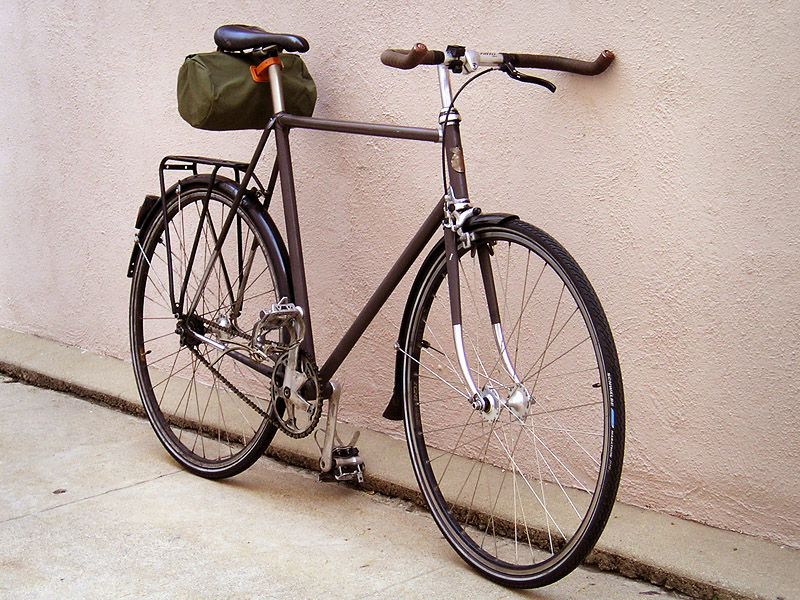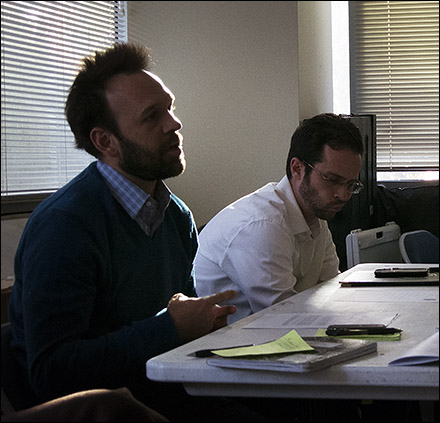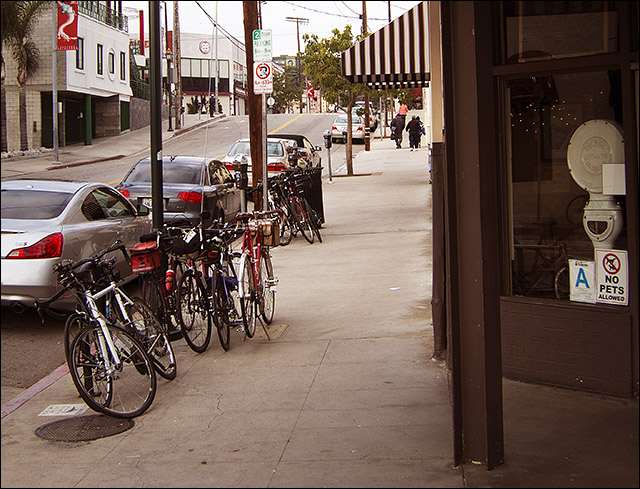About halfway to my goal (the depositing of a mighty six dollar and ninety-nine cent rebate check), I saw a fellow crossing the street at the next corner on what looked like an old Dutch bike, complete with chaincase, skirtguard, and double top tubes.
Those aren't all that rare here, but to complete the picture, the handsome young gentleman pedaling it was wearing a slacks, blazer, elegant loafers, and a straw hat. Not a Huckleberry Finn straw hat, but a dressy one. And he was talking on a cell phone as he blithely rolled across one of the busiest streets in LA and onto a crowded sidewalk.
Mind you, his pace was deliberate in the extreme.
He pulled into the courtyard of the building where I too was headed and stopped to concentrate on his phone call. When I passed I heard him discussing some sort of business deal. I took a glance at the bike, which was a modern bike built in the traditional Dutch style, but couldn't discern the brand name.
When I had finished with my business and come out, he was still deep in his phone conference.
Quite possibly he works there. The building is full of creative offices, though some, such as the Los Angeles Business Journal, are conservative creative offices. The building hosts a large bike corral out front and (so the signs indicate) more secure bike parking in one of the garages.
I see more and more folks of every sort cycling in the neighborhood lately. It's most gratifying!
Richard Risemberg on Thu, 31 Jan 2013 21:20:35 -0800 [link]
Read on!
Richard Risemberg on Wed, 30 Jan 2013 09:46:33 -0800 [link]
At least I figure it was to work, given that it was a quarter to nine and that one was wearing a suit. (A tweed suit, in fact, which must have been pleased to find itself in its natural rainy habitat at last.) At least one rider was a snappily-dressed young woman.
I was also pleased to note six or seven more bikes parked in front of office buildings.
This was all within a very short distance in the Miracle Mile, which was—O irony!—originally designed as the country's first automobile-oriented business district, with huge parking lots occupying the back half off each block and front doors behind the buildings.
Well, now cars have crowded themselves out of contention in the transportation matrix: Metro's Rapid buses carry 20% more passengers through the Mile (and along the full length of Wilshire) than all the cars combined, and more and more people are choosing to bicycle into the district in all weathers.
And as stores open up sidewalk entrances, street life is becoming more and more convivial.
I must admit that the extensive bike corral maintained by one more modern building was less than half-full today, when it is usually packed. Still, it's a good showing for LA, and it's very good to see the city growing up. LA has long been developmentally-challenged, but the cure is starting to take.
Richard Risemberg on Thu, 24 Jan 2013 14:18:14 -0800 [link]
A delightful if perhaps a shade too leisurely for my taste, to be sure.... But I'm getting used to the pace of these things, and don't let it distract me from the pleasures.
Richard Risemberg on Wed, 23 Jan 2013 15:39:08 -0800 [link]
 Today is Tuesday, when I usually ride out to South Pasadena to spend an hour or so with Vélo Ré's Chuck Schmidt and some pastry at Buster's Coffee by the Gold LIne station. (Today I cheated a bit on the way in by taking the subway from Western Avenue to Downtown, cutting out the least amusing part of the trip.)
Today is Tuesday, when I usually ride out to South Pasadena to spend an hour or so with Vélo Ré's Chuck Schmidt and some pastry at Buster's Coffee by the Gold LIne station. (Today I cheated a bit on the way in by taking the subway from Western Avenue to Downtown, cutting out the least amusing part of the trip.)While we were there, a fellow named Andy pulled up riding a very sweet Signal city bike—everything just so: matching painted fenders, dyno hub, internal gears, constructeur-style rack, Brooks saddle. He mentioned something about wanting to be able to take longer rides and haul stuff, and not worrying about bike weight.
Not to diminish the appeal or utility of his bike in any way, but I must say that it made me realize how pared-down my own bike is, and how much I personally like it that way.
An Italian racing frame nearly fifty years old, set up with a fixed gear, polycarbonate fenders (which I reviewed here a few years back), a pricey but minimalist Tubus Fly rack, a couple of lights, a bag, and a used saddle.
Andy was a bit surprised to hear that my old Bottecchia, locked to a signpost on the sidewalk, has nearly forty thousand miles on it under my stewardship. And I do reasonably long rides on it and carry stuff.
I like it that way. I rarely need to do maintenance on it—tires and chain, batteries, a brake cable every half decade. (I do hope to put dyno hub lighting on it this year.)
Mostly I just ride it. Everywhere.
It's an unassuming bike, but it goes and goes and goes.
I love looking at custom bikes. But I've never owned a bike I enjoyed riding more than that brown Bottecchia in the photo.
Richard Risemberg on Tue, 22 Jan 2013 19:27:52 -0800 [link]
At Orange 20, I go over the wonderful news that this year we'll have CicLAvia x 3!
And at Flying Pigeon LA, I talk about getting In Training with Metro's progressive, permissive bikes-on-trains program.
And that'll have to do for now....
Richard Risemberg on Wed, 16 Jan 2013 16:07:47 -0800 [link]
The doctors haven't specifically mentioned sprinting, but I am taking no chances, as I'd very much like the stroke to be a singular experience.
In a way, this fits in perfectly with my philosophy of cycling, in that I don't think we should try to emulate motorists and hurry through the city as fast and as blind to its street life and scenery as possible. After all, if I were in a hurry I'd go back to motorcycles.
This is what I believe. But, of course, I get caught up in the general frenzy of traffic, and also I have let a bit of pride in power subvert me, so I enjoyed sprinting from stoplights and hammering up hills, as well as getting across town faster than driving friends do.
Then, I worried a bit: would it be safe to ride at a slower pace in LA's mad traffic? Would I get places late?
As it turns out, No. I take a little longer than before to get across town, but it's not enough to fret over. Still faster than cars at peak hours, and much more relaxing.
Hills haven't been a problem either. I take them much more slowly, but, even on the fixie, I can clean them without making anything even remotely approaching a Herculean effort if I slow down. Once in a rare while, on steeper hills, I get off and walk the bike. This has happened twice in three months.
And I've had no problems integrating with fast traffic. It turns out that, if you are patient, you find the gaps you need for a deliberate and unhurried passage even across what appears to be a raging stream of hot metal.
First impressions are so often wrong.
Today, for example, I approached the Glendale-Hyperion bridge from the east. This is a double bridge, with an upper and a lower span, each of which goes to a different area. I wanted the upper span, which meant that, from my position on the far right, I had to cross the two lanes that veered to the lower span and merge into one of the lanes that cross the upper, with motor traffic zipping along fairly quickly. In the end, I stopped at the curb and waited for a gap...waited about twelve seconds, as it turned out. Then I eased into my lane and started across the bridge.
This span not only has narrow lanes, but it slopes upward to a bluff, so is quite a climb. I didn't hurry, just pedaled along, keeping part of my attention on traffic behind me but resolutely not hurrying. Even getting around the construction crew that blocked my lane partway up presented no difficulties. I crested the hill and rolled down into Silverlake more relaxed than I ever did before my affliction.
And this is just the latest lesson in riding slowly through traffic.
It's been repeated over and over, even on streets where I felt sure I'd be the audience for a chorus of angry honks. In fact, I've been enjoying riding more as I hurry less, and I get everywhere I need to get to—in some instances my destinations are nearly twenty miles off—without strain or conflict.
And this in Los Angeles!
Quite a revelation.
Richard Risemberg on Tue, 15 Jan 2013 17:10:17 -0800 [link]
 That's Los Angeles Department of Transportation Bicycle Program Coordinator Nate Baird in the foreground, answering a question at yesterday's Bicycle Plan Implementation Team meeting. Beside him is engineer Tim Frémaux.
That's Los Angeles Department of Transportation Bicycle Program Coordinator Nate Baird in the foreground, answering a question at yesterday's Bicycle Plan Implementation Team meeting. Beside him is engineer Tim Frémaux.This meeting occurs quarterly, and the "team" is whoever shows up—advocates, everyday riders, neighborhood council folks, city council staffers, public health advocates, and the occasional curious soul who chanced upon an online notice—plus DOT and City Planning Department staff, including long-suffering moderator David Somers.
In the past the meetings have all too often been contentious, not only because of people fearful fo the changes opening LA's streets up to cyclists and other non-motorized users might bring, but often because of our own divisions within the bicycle advocacy community.
But I am glad to say that yesterday's meeting was quiet, serious, and mostly businesslike—though, as is the case in any gathering where everyone has an agenda of some sort, the discussion did occasionally wander. (I fear I may have contributed a bit of thematic meander myself, I must confess.)
Anyway, we heard an update on progress in painting lanes, heard a bit about funding programs, and spent most of the time discussing the bicycle-friendly streets plan, more properly called the Neighborhood Greenways network.
Perhaps because for the first time in decades actual progress has been made by our beleaguered DOT, there was less impetus to indulge in outrage or indignation. This is a good thing, so I am glad to report that there wasn't much excitement to report this time around‐the sound of gears turning smoothly, after all, by definition does not stand out!
While there's always more that can be done, and there is definitely much more that must be done, we are moving forward. Los Angeles is becoming a city that no longer quite so stringently mandates that one fire up a motorcar for every displacement, no matter how insignificant.
For this city, that's major progress.
Richard Risemberg on Wed, 09 Jan 2013 20:34:18 -0800 [link]
Richard Risemberg on Wed, 09 Jan 2013 13:29:38 -0800 [link]
Richard Risemberg on Wed, 02 Jan 2013 09:38:22 -0800 [link]
And instead of the beach, I headed Downtown...where I was pleased to see plenty of other folks on New Year's Day bike rides themselves, as well as plenty of bikes parked in front of nearly every eatery of any sort that was open.
The prize find must be this Triple Bike Pile at Philippe's on Alameda:

Have you ever noticed that a bike bell sounds an awful lot like the ka-ching! of an old-fashioned cash register?
All those bikes, taking up no more space in the aggregate than a single car or van.
As I rode back home along Sunset, I counted numerous similar scenes all through Echo Park and Silverlake.
Of course, all sorts of embarrassing studies are coming out showing that traffic lanes and giant parking lots don't do as much for a local economy as bike lanes and a few cheap racks. (See a recent post of mine on that very subject here.)
Really, all car culture is designed to do is shoot pods of isolated "consumer units" right past anything redolent of neighborhood culture or regional commerce, and deposit them in front of the gates of their masters' bigbox stores. There they vacuum the cash out of the consumer units' pockets and deposit it, in its turn, in the bank accounts of distant uninvolved shareholders. (They also suck tax dollars from municipal treasuries...read more on that here.
Moving cars doesn't really matter. Moving hearts towards each other does, and a healthier economy follows in the wake of neighborliness. But none of that works when we're all trapped in steel boxes rushing towards the next phony markdown....
The bicycle, this year and onwards!
Richard Risemberg on Tue, 01 Jan 2013 14:34:53 -0800 [link]



